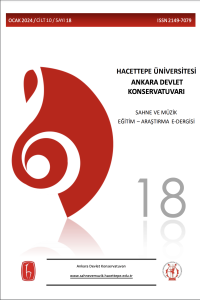METRIC ASYMMETRY AS A MEANS OF MOVEMENT IN THE EXTENDED MONOPHONY TECHNIQUE AND GYÖRGY LIGETI'S MUSICA RICERCATA 1 AS A FUNCTIONAL EXAMPLE
Öz
In this study, Metric Asymmetry, defined within the composition technique we call Extended Monophony, is illustrated and in this context, György Ligeti's, Musica Ricercata 1, is analyzed respectively.
It is seen that, unlike common, traditional motion tools based on verticality such as harmony or counterpoint, Metric Asymmetry can be used as a dramatic-motion tool even within monophonic texture since it is not related to the number of parts in the music. In the analysis, it has been revealed that motion might be achieved by applying Metrical Asymmetry on only a single note, while eliminating all devices such as tonal/modal centers or movement schemata—even melodic lines.
Respectively, it has been seen that Metric Asymmetry is an essential and quite effective phenomenon in terms of Extended Monophony, which aims to create multi-layered textures within monophony, and it has been suggested that the limits of its expansion should also be investigated thoroughly for sake of a fresh, new musical discourse and grammar.
Kaynakça
- Benward, B., & Saker, M. N. (2003). Music: In Theory and Practice, Vol. 1. Boston: McGraw- Hill.
- Çakar, Ş. Ş. (2004). Türk Müziği Teorisi ve Makamlar. Ankara: Milli Eğitim Bakanlığı Y ayınları.
- Cone, E. T. (1962). Stravinsky: The Progress of a Method. Perspectives of New Music, 1(1), 18-26.
- Craft, R. (1959). Conversations with Igor Stravinsky. New York: Doubleday & Company.
- Dunsby, J. (1989, February). Considerations of Texture. Music & Letters, 70(1), 46-57.
- Dyson, G. (1923, Nisan). The Texture of Modern Music. Music & Letters, 4(2), 107-118.
- Griffiths, P. (1983). György Ligeti. London: Robson Books.
- Karadeniz, M. E. (1980). Türk Musikîsinin Nazariye ve Esasları. Ankara: Türkiye İş Bankası Kültür Yayınları.
- Kerekfy, M. (2008, September). 'A "New Music" from Nothing': György Ligeti's Musica ricercata. Study Musicologica, 49(3/4), 230-230
- Lester, J. (1989). Analytical Approaches to Twentieth-Century Music. New York: W. W. Norton.
- Ligeti, G. (1967). Requiem / Lontano / Continuum (CD booklet). France: Studio Reihe Neuer Musik.
- Mirriam-Webster. (2022, Mayıs 12). Texture. Mirriam-Webster: mirriam-webster.com adresinden alındı
- Mirriam-Webster. (2022, Mayıs 12). Texture. Retrieved from Mirriam-Webster: mirriam- webster.com
- Nietzsche, F. (2005). Tragedyanın Doğuşu (Çev. Mustafa Tüzel). İstanbul: İthaki Yayınları.
- Ringer, A. L. (2023, May 1). Melody. Retrieved from Grove Music Online: https://www.oxfordmusiconline.com/grovemusic/view/10.1093/gmo/97815615926 30.001.0001/omo-9781561592630-e-0000018357.
- Scholes, P. (1970). "Metre", The Oxford Companion to Music, ed. John Owen Ward. London and New York: Oxford University Press.
- Taruskin, R. (2010). Music in the Early Twentieeth Cenruty. New York: Oxford University Press
- Toorn, P. C. (1987). Stravinsky and The Rite of Spring. New York: Oxford University Press
- Yavaşça, A. (2002). Türk Mûsıkîsi'nde Kompozisyon ve Beste Biçimleri. İstanbul: Türk Kültürüne Hizmet Vakfı Yayınları.
GENİŞLETİLMİŞ TEKSESLİLİK ANLAYIŞINDA DEVİNİM ARACI OLARAK METRİK ASİMETRİ VE BUNA İŞLEVSEL BİR ÖRNEK OLARAK GYÖRGY LİGETİ’NİN MUSICA RICERCATA’SINDAN 1. BÖLÜM
Öz
Bu çalışmada, “Genişletilmiş Tekseslilik” olarak adlandırdığımız bestecilik tekniği içerisinde tanımlanan Metrik Asimetri nosyonu açıklanmış ve György Ligeti’nin, Musica Ricercata başlıklı yapıtının birinci bölümü, ilgili bağlamda analiz edilmiştir.
Armoni veya kontrpuan gibi müziğin alışageldik, geleneksel, dikey düzleme koşut devinim araçlarının aksine Metrik Asimetri’nin, parti sayısı ile alâkalı bir araç olmadığı için teksesli doku içerisinde dramatik-devinimsel bir araç olarak kullanılabildiği görülmektedir. Analiz edilen örnekte, devinimin, çekim merkezleri veya hareket şeması gibi araçların, dahası ezgiselliğin devre dışı bırakıldığı; yalnızca tek bir ses üzerinde metrik asimetri uygulanarak sağlanabildiği ortaya konulmuştur.
Metrik Asimetri’nin, tekseslilik içerisinde çok katmanlı dokular yaratma amacı taşıyan Genişletilmiş Tekseslilik açısından son derece işlevsel, bir oranda da zarurî bir fenomen olduğu görülmüş ve yenice bir müzikal deyiş ve gramer için genişleme sınırlarının daha da yetkinlikle araştırılması gerektiği önerilmiştir.
Anahtar Kelimeler
Kaynakça
- Benward, B., & Saker, M. N. (2003). Music: In Theory and Practice, Vol. 1. Boston: McGraw- Hill.
- Çakar, Ş. Ş. (2004). Türk Müziği Teorisi ve Makamlar. Ankara: Milli Eğitim Bakanlığı Y ayınları.
- Cone, E. T. (1962). Stravinsky: The Progress of a Method. Perspectives of New Music, 1(1), 18-26.
- Craft, R. (1959). Conversations with Igor Stravinsky. New York: Doubleday & Company.
- Dunsby, J. (1989, February). Considerations of Texture. Music & Letters, 70(1), 46-57.
- Dyson, G. (1923, Nisan). The Texture of Modern Music. Music & Letters, 4(2), 107-118.
- Griffiths, P. (1983). György Ligeti. London: Robson Books.
- Karadeniz, M. E. (1980). Türk Musikîsinin Nazariye ve Esasları. Ankara: Türkiye İş Bankası Kültür Yayınları.
- Kerekfy, M. (2008, September). 'A "New Music" from Nothing': György Ligeti's Musica ricercata. Study Musicologica, 49(3/4), 230-230
- Lester, J. (1989). Analytical Approaches to Twentieth-Century Music. New York: W. W. Norton.
- Ligeti, G. (1967). Requiem / Lontano / Continuum (CD booklet). France: Studio Reihe Neuer Musik.
- Mirriam-Webster. (2022, Mayıs 12). Texture. Mirriam-Webster: mirriam-webster.com adresinden alındı
- Mirriam-Webster. (2022, Mayıs 12). Texture. Retrieved from Mirriam-Webster: mirriam- webster.com
- Nietzsche, F. (2005). Tragedyanın Doğuşu (Çev. Mustafa Tüzel). İstanbul: İthaki Yayınları.
- Ringer, A. L. (2023, May 1). Melody. Retrieved from Grove Music Online: https://www.oxfordmusiconline.com/grovemusic/view/10.1093/gmo/97815615926 30.001.0001/omo-9781561592630-e-0000018357.
- Scholes, P. (1970). "Metre", The Oxford Companion to Music, ed. John Owen Ward. London and New York: Oxford University Press.
- Taruskin, R. (2010). Music in the Early Twentieeth Cenruty. New York: Oxford University Press
- Toorn, P. C. (1987). Stravinsky and The Rite of Spring. New York: Oxford University Press
- Yavaşça, A. (2002). Türk Mûsıkîsi'nde Kompozisyon ve Beste Biçimleri. İstanbul: Türk Kültürüne Hizmet Vakfı Yayınları.
Ayrıntılar
| Birincil Dil | Türkçe |
|---|---|
| Konular | Klasik Batı Müziğinde Kompozisyon |
| Bölüm | Makaleler |
| Yazarlar | |
| Yayımlanma Tarihi | 14 Ocak 2024 |
| Gönderilme Tarihi | 14 Kasım 2023 |
| Kabul Tarihi | 3 Ocak 2024 |
| Yayımlandığı Sayı | Yıl 2024 Cilt: 10 Sayı: 18 |


